This article needs additional citations for verification .(August 2015) |

The Lovers (VI) is the sixth trump or Major Arcana card in most traditional Tarot decks. It is used in game playing as well as in divination.
Contents
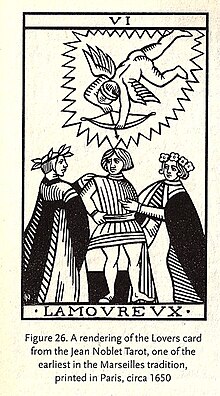
This article needs additional citations for verification .(August 2015) |

The Lovers (VI) is the sixth trump or Major Arcana card in most traditional Tarot decks. It is used in game playing as well as in divination.

According to A.E. Waite's 1910 book Pictorial Key to the Tarot, the Lovers card carries several divinatory associations: [1]
6. THE LOVERS.—Attraction, love, beauty, trials overcome. Reversed: Failure, foolish designs. Another account speaks of marriage frustrated and contrarieties of all kinds.
In some traditions, the Lovers represent relationships and choices. Its appearance in a spread indicates some decision about an existing relationship, a temptation of the heart, or a choice of potential partners. Often an aspect of the Querent's life will have to be sacrificed; a bachelor(ette)'s lifestyle may be sacrificed and a relationship gained (or vice versa), or one potential partner may be chosen while another is turned down. Whatever the choice, it should not be made lightly, as the ramifications will be lasting.
The Lovers is associated with the star sign Gemini, and indeed is also known as The Twins in some decks. Other associations are with Air, Mercury, and the Hebrew letter ז (Zayin).
In the Rider Waite deck, the imagery for this card is changed significantly from the traditional depiction. Instead of a couple receiving a blessing from a noble or cleric, the Rider–Waite deck depicts Adam and Eve in the Garden of Eden. By reducing the number of human beings depicted in the card from three to two, Waite was able to reinforce its correspondence with Gemini. [2] The Rider–Waite card also includes the Tree of the knowledge of good and evil with a serpent wrapped around its trunk. The symbolism of no return from making bad decisions, and the consequences of innocence lost, would be more widely understood from this imagery. [3]

The Rider–Waite Tarot is a widely popular deck for tarot card reading. It is also known as the Waite–Smith, Rider–Waite–Smith, or Rider Tarot. Based on the instructions of academic and mystic A. E. Waite and illustrated by Pamela Colman Smith, both members of the Hermetic Order of the Golden Dawn, the cards were originally published by the Rider Company in 1909. The deck has been published in numerous editions and inspired a wide array of variants and imitations. It is estimated that more than 100 million copies of the deck exist in more than 20 countries.

The Magician (I), also known as The Magus or The Juggler, is the first trump or Major Arcana card in most traditional tarot decks. It is used in game playing and divination; in the English-speaking world, the divination meaning is much better known.

The High Priestess (II) is the second Major Arcana card in cartomantic Tarot decks. It is based on the 2nd trump of Tarot card packs. In the first Tarot pack with inscriptions, the 18th-century woodcut Tarot de Marseilles, this figure is crowned with the Papal tiara and labelled La Papesse, the Popess, a possible reference to the legend of Pope Joan.

The Empress (III) is the third trump or Major Arcana card in traditional tarot decks. It is used in card games as well as divination.
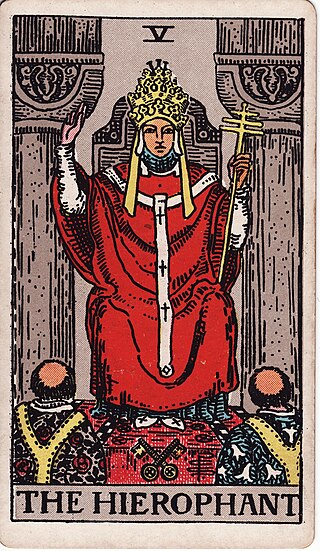
The Hierophant (V), alternatively depicted as The Pope or The High Priest (as a counterpart to "The High Priestess") is the fifth card of the Major Arcana in occult Tarot decks used in divination. It was identified as the Pope in early decks like Tarot of Marseilles, while modern decks like Rider–Waite Tarot may use the term hierophant (Ancient Greek: ἱεροφάντης), a person who brings religious congregants into the presence of that which is deemed "holy".

The Hanged Man (XII) is the twelfth Major Arcana card in most traditional tarot decks. It is used in game playing as well as in divination.
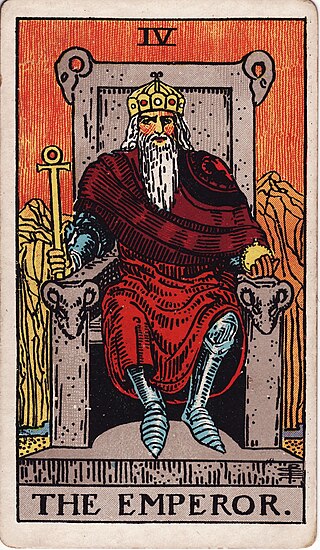
The Emperor (IV) is the fourth trump or Major Arcana card in traditional tarot decks. It is used in game playing as well as in divination.

Strength is a Major Arcana tarot card, and is numbered either XI or VIII, depending on the deck. Historically it was called Fortitude, and in the Thoth Tarot deck it is called Lust. This card is used in game playing as well as in divination.

The Hermit (IX) is the ninth trump or Major Arcana card in most traditional tarot decks. It is used in game playing as well as in divination.
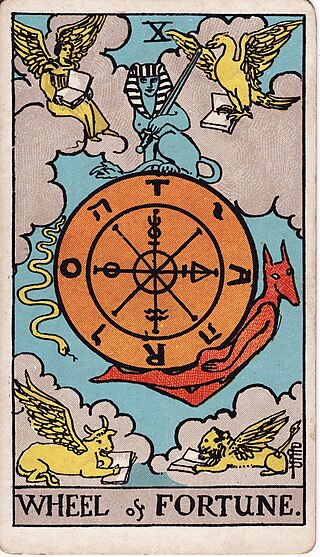
Wheel of Fortune is one of 78 cards in a tarot deck and is the tenth trump or Major Arcana card in most tarot decks. It is used in game playing as well as in divination.

Justice is a Major Arcana tarot card, numbered either VIII or XI, depending on the deck. This card is used in game playing as well as in divination.
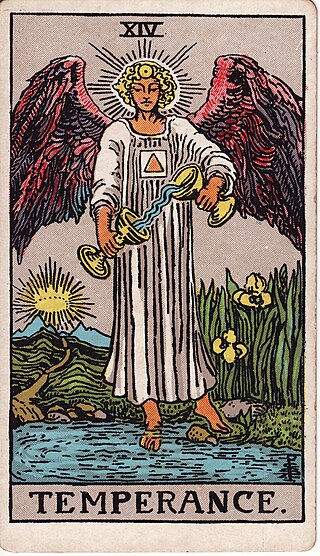
Temperance (XIV) is one of the 22 Major Arcana cards in Tarot decks. It is usually numbered 14. It depicts a figure which represents the virtue Temperance. Along with Justice and Strength, it is one of three Virtues which are given their own cards in traditional tarot. It is used in both game playing and in divination.

The Devil (XV) is the fifteenth trump or Major Arcana card in most traditional tarot decks. It is used in game playing as well as in divination.

The Star (XVII) is the 17th ranking or Major Arcana card in most traditional tarot decks. It is used in game playing as well as in divination.

The Moon (XVIII) is the eighteenth trump or Major Arcana card in most traditional tarot decks. It is used in game playing as well as in divination.

The Sun (XIX) is the nineteenth trump or Major Arcana card in most traditional tarot decks. It is used in game playing as well as in divination.

The World (XXI) is the 21st trump or Major Arcana card in the tarot deck. It can be incorporated as the final card of the Major Arcana or tarot trump sequence (the first or last optioned as being "The Fool" (0). It is associated with the 22nd letter of the Hebrew alphabet, 'Tau', also spelled 'Tav' or 'Taw'.

Judgement (XX), or in some decks spelled Judgment, is a tarot card, part of the Major Arcana suit usually comprising 22 cards.

The suit of goblets, more often known in modern times as the Suit of Cups, is one of four suits of tarot which, collectively, make up the Minor Arcana. They are sometimes referred to as chalices. Like the other suits of the Minor Arcana, it contains fourteen cards: ace (one), two through ten, page, knight, queen and king. Historically, the suit represented the First Estate. Tarot cards were originally designed for card play and are still used throughout much of Europe to play various Tarot card games. However, in English-speaking countries, where the games are largely unknown, Tarot cards came to be utilized primarily for divinatory purposes. In modern card games, the equivalent suits are Hearts or Cups.

The Fool is one of the 78 cards in a tarot deck. In tarot card reading, it is one of the 22 Major Arcana, sometimes numbered as 0 or XXII. However, in decks designed for playing traditional tarot card games, it is typically unnumbered, as it is not one of the 21 trump cards and instead serves a unique purpose by itself.
{{cite book}}: CS1 maint: multiple names: authors list (link) CS1 maint: numeric names: authors list (link)A selection of ten prop tarot cards designed by Fergus Hall, used by Jane Seymour as Solitaire in Live and Let Die - [...] The cards comprising 'The Fool', 'Death', 'Justice', 'Queen of Cups', 'High Priestess'(2) and 'The Lovers' (4), the back of the cards with a red and white 007 design;